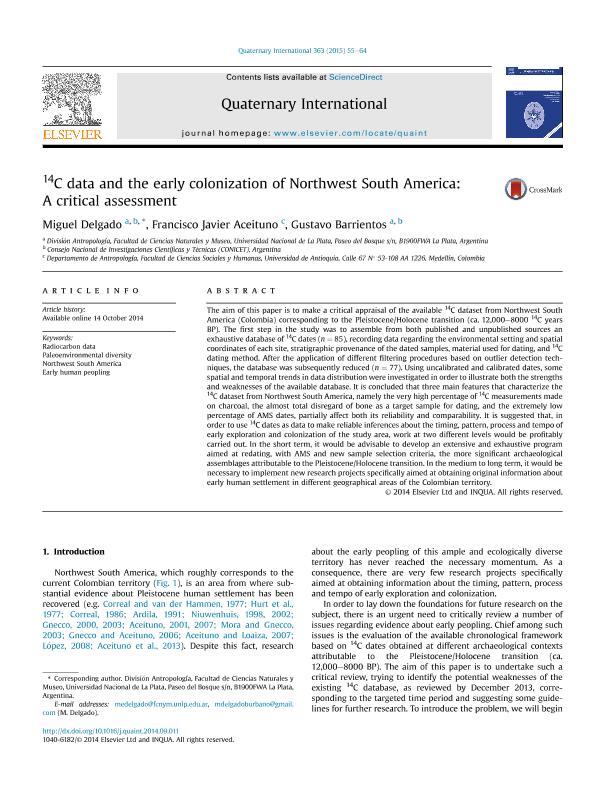Mostrar el registro sencillo del ítem
dc.contributor.author
Delgado Burbano, Miguel Eduardo

dc.contributor.author
Aceituno Bocanegra, Francisco Javier

dc.contributor.author
Barrientos, Gustavo

dc.date.available
2018-06-26T19:57:25Z
dc.date.issued
2015-03
dc.identifier.citation
Delgado Burbano, Miguel Eduardo; Aceituno Bocanegra, Francisco Javier; Barrientos, Gustavo; 14C data and the early colonization of Northwest South America: A critical assessment; Pergamon-Elsevier Science Ltd; Quaternary International; 363; 3-2015; 55-64
dc.identifier.issn
1040-6182
dc.identifier.uri
http://hdl.handle.net/11336/50142
dc.description.abstract
The aim of this paper is to make a critical appraisal of the available 14C dataset from Northwest South America (Colombia) corresponding to the Pleistocene/Holocene transition (ca. 12,000-8000 14C years BP). The first step in the study was to assemble from both published and unpublished sources an exhaustive database of 14C dates (n=85), recording data regarding the environmental setting and spatial coordinates of each site, stratigraphic provenance of the dated samples, material used for dating, and 14C dating method. After the application of different filtering procedures based on outlier detection techniques, the database was subsequently reduced (n=77). Using uncalibrated and calibrated dates, some spatial and temporal trends in data distribution were investigated in order to illustrate both the strengths and weaknesses of the available database. It is concluded that three main features that characterize the 14C dataset from Northwest South America, namely the very high percentage of 14C measurements made on charcoal, the almost total disregard of bone as a target sample for dating, and the extremely low percentage of AMS dates, partially affect both its reliability and comparability. It is suggested that, in order to use 14C dates as data to make reliable inferences about the timing, pattern, process and tempo of early exploration and colonization of the study area, work at two different levels would be profitably carried out. In the short term, it would be advisable to develop an extensive and exhaustive program aimed at redating, with AMS and new sample selection criteria, the more significant archaeological assemblages attributable to the Pleistocene/Holocene transition. In the medium to long term, it would be necessary to implement new research projects specifically aimed at obtaining original information about early human settlement in different geographical areas of the Colombian territory.
dc.format
application/pdf
dc.language.iso
eng
dc.publisher
Pergamon-Elsevier Science Ltd

dc.rights
info:eu-repo/semantics/openAccess
dc.rights.uri
https://creativecommons.org/licenses/by-nc-nd/2.5/ar/
dc.subject
Early Human Peopling
dc.subject
Northwest South America
dc.subject
Paleoenvironmental Diversity
dc.subject
Radiocarbon Data
dc.subject.classification
Historia

dc.subject.classification
Historia y Arqueología

dc.subject.classification
HUMANIDADES

dc.title
14C data and the early colonization of Northwest South America: A critical assessment
dc.type
info:eu-repo/semantics/article
dc.type
info:ar-repo/semantics/artículo
dc.type
info:eu-repo/semantics/publishedVersion
dc.date.updated
2018-06-26T13:42:35Z
dc.journal.volume
363
dc.journal.pagination
55-64
dc.journal.pais
Estados Unidos

dc.description.fil
Fil: Delgado Burbano, Miguel Eduardo. Consejo Nacional de Investigaciones Científicas y Técnicas; Argentina. Universidad Nacional de La Plata. Facultad de Cienicas Naturales y Museo. División Antropología; Argentina
dc.description.fil
Fil: Aceituno Bocanegra, Francisco Javier. Universidad de Antioquia; Colombia
dc.description.fil
Fil: Barrientos, Gustavo. Consejo Nacional de Investigaciones Científicas y Técnicas; Argentina. Universidad Nacional de La Plata. Facultad de Cienicas Naturales y Museo. División Antropología; Argentina
dc.journal.title
Quaternary International

dc.relation.alternativeid
info:eu-repo/semantics/altIdentifier/doi/http://dx.doi.org/10.1016/j.quaint.2014.09.011
dc.relation.alternativeid
info:eu-repo/semantics/altIdentifier/url/https://www.sciencedirect.com/science/article/pii/S1040618214006582
Archivos asociados
